Janome 5024 Decor Excel II Instruction Manual

INSTRUCTION BOOK
IMPORTANT SAFETY INSTRUCTIONS
When using an electrical appliance, basic safety precautions should always be followed, including the followings:
Read all instructions before using this appliance.
DANGER— To reduce the risk of electric shock:
1.An appliance should never be left unattended when plugged in. Always unplug this sewing machine from the electric outlet immediately after using and before cleaning.
2.Always unplug before replacing a sewing machine bulb. Replace bulb with same type rated 15 Watts.
WARNING— To reduce the risk of burns, fire, electric shock, or injury to persons:
1.Do not allow to be used as a toy. Close attention is necessary when this sewing machine is used by or near children.
2.Use this appliance only for its intended use as described in this owner’s manual.
Use only attachments recommended by the manufacturer as contained in this owner’s manual.
3.Never operate this sewing machine if it has a damaged cord or plug, if it is not working properly, if it has been dropped or damaged, or dropped into water.
Return this sewing machine to the nearest authorized dealers or service center for examination, repair, electrical or mechanical adjustment.
4.Never operate the appliance with any air opening blocked. Keep ventilation openings of this sewing machine and foot controller free from accumulation of lint, dust and loose cloth.
5.Never drop or insert any object into any opening.
6.Do not use outdoors.
7.Do not operate where aerosol (spray) products are being used or where oxygen is being administered.
8.To disconnect, turn all controls to the off (“0”) position, then remove plug from outlet.
9.Do not unplug by pulling on cord. To unplug, grasp the plug, not the cord.
10.Keep fingers away from all moving parts. Special care is required around the sewing machine needle.
11.Always use the proper needle plate. The wrong plate can cause the needle to break.
12.Do not use bent needles.
13.Do not pull or push fabric while stitching. It may deflect the needle causing it to break.
14.Switch this sewing machine off (“0”) when making any adjustment in the needle area, such as threading the needle, changing the needle, threading the bobbin or changing the presser foot, and the like.
15.Always unplug this sewing machine from the electrical outlet when removing covers, lubricating, or when making any other adjustments mentioned in this owner’s manual.
SAVE THESE INSTRUCTIONS
Table of Contents |
|
Names of Parts .................................................... |
2 |
Detachable Extension Table ................................. |
3 |
Accessory Storage Compartment ........................ |
4 |
Connecting Machine to Power Supply ................. |
5 |
Foot Control ......................................................... |
5 |
Sewing Light ......................................................... |
6 |
• To replace the light bulb ................................ |
6 |
Pressure Dial ........................................................ |
6 |
To Raise or Drop the Feed Dog ........................... |
6 |
To Remove and Attach Presser Foot ................... |
7 |
To Remove and Attach the Foot Holder ............... |
7 |
Reverse Button .................................................... |
7 |
Presser Foot Lifter................................................ |
7 |
Changing Needle ................................................. |
8 |
Choose Your Needle and Thread ......................... |
8 |
Winding the Bobbin .............................................. |
9 |
• Set the Spool ................................................. |
9 |
• Removing the Bobbin .................................... |
9 |
• Winding the Bobbin ..................................... |
10 |
• Inserting the Bobbin .................................... |
11 |
Threading the Machine ...................................... |
12 |
• Needle Threader ......................................... |
13 |
• Drawing Up the Bobbin Thread ................... |
14 |
Adjust the Top Thread Tension ........................... |
15 |
• Choose the Correct Tension ........................ |
15 |
• Tension is too tight....................................... |
15 |
• Tension is too loose ..................................... |
15 |
Pattern Selector Dial .......................................... |
16 |
Zigzag Width Control .......................................... |
16 |
Stitch Length Control.......................................... |
16 |
Infinite Needle Position ...................................... |
16 |
Straight Stitching ................................................ |
17 |
• Starting to Sew ............................................ |
17 |
• Changing Sewing Direction ......................... |
17 |
• Finishing Sewing ......................................... |
17 |
Sewing on Heavy Fabrics .................................. |
18 |
Seam Allowance Lines ....................................... |
18 |
Turn a Square Corner ........................................ |
18 |
Zigzag Stitching .................................................. |
19 |
Overcasting ........................................................ |
19 |
Overedge Stitch ................................................. |
20 |
Tricot Stitch ........................................................ |
20 |
Triple Strength Stitch .......................................... |
21 |
Outline Stretch Stitch ......................................... |
21 |
Sewing Buttons .................................................. |
22 |
Automatic Buttonhole ................................... |
23–25 |
• To Alter the Stitch Density ........................... |
25 |
Corded Buttonhole ............................................. |
26 |
Zipper Sewing .............................................. |
27–28 |
• To Snap On the Zipper Foot ........................ |
27 |
• Fabric Preparation ....................................... |
27 |
• To Sew................................................... |
27–28 |
Rolled Hem ........................................................ |
29 |
Blind Stitch Hemming ......................................... |
30 |
Decorative Satin Stitch Patterns ........................ |
31 |
Stretch Stitch Patterns ....................................... |
31 |
Adjusting Stretch Stitch Balance ........................ |
32 |
Smocking ........................................................... |
32 |
Quilting ............................................................... |
33 |
Pin Tucking ......................................................... |
33 |
Shell Tuck ........................................................... |
34 |
Fagoting ............................................................. |
34 |
Appliqué ............................................................. |
35 |
Patch Work ......................................................... |
35 |
Scallop Hems ..................................................... |
36 |
Elastic Stitch ....................................................... |
36 |
Care of Your Machine......................................... |
37 |
• Cleaning the Hook Race and |
|
Feed Dog .................................................... |
37 |
• Replacing the Bobbin Holder ...................... |
37 |
Troubleshooting ........................................... |
38–39 |
1
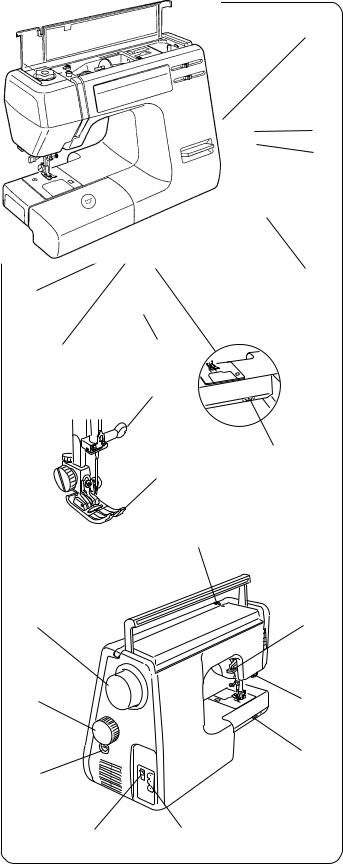
6 5 4 3
7 |
|
|
8 |
2 |
|
1 |
||
|
9
10
14
11
12 13
15
26
16
25
24
17
18 |
23 |
22
19
20 21
Names of Parts
1.Stitch length control
2.Zigzag width control
3.Foot storage compartment
4.Flip-top sewing instruction panel
5.Top cover
6.Thread tension dial
7.Pressure dial
8.Face plate
9.Thread cutter
10.Needle threader
11.Hook cover plate
12.Hook cover plate release button
13.Extension table (Accessory storage box)
14.Reverse button
15.Needle clamp screw
16.Presser foot
17.Handwheel
18.Pattern selector dial
19.Feed balance dial
20.Power switch
21.Machine socket
22.Drop feed lever
23.Buttonhole lever
24.Presser foot lifter
25.Thread take-up lever
26.BH pitch balance adjusting dial
2

Detachable Extension Table
For Free Arm Sewing
To remove, lift out the extension table toward you as illustrated.
Advantages of free arm sewing:
*Avoid fabric bunching around the needle when bar tacking to reinforce pockets, plackets and waistlines.
*For stitching sleeves, waistbands, pants legs, or any circular garment area.
*For darning socks or mending knees, elbows,or areas of wear in children’s clothes.
For Flat-bed Sewing
Position the tabs on the base grooves and push down gently.
 Extension table
Extension table
 Tabs
Tabs
 Base grooves
Base grooves
3

|
|
|
Accessory Storage Compartment |
|
1 |
2 |
3 |
1. |
Set of needles |
|
|
|
||
|
|
|
2. |
L: Quilter |
|
|
|
3. |
G: Blind stitch hem foot |
|
|
4 |
4. |
D: Hemmer foot |
|
G |
|
5. E: Zipper foot |
|
|
L |
|
6. |
A: Zigzag foot |
|
D |
|
||
|
|
7. |
F: Satin stitch foot |
|
|
C |
5 |
||
|
8. C: Overedge foot |
|||
|
|
|||
|
F |
|
||
8 |
A |
E |
|
|
7 |
6 |
|
|
|
9 |
10 |
|
11 |
|
|
|
12 |
|
|
14 |
|
13 |
15 |
16 |
17 |
|
|
18 |
19
9.Extension table
Open the extension table toward you for a convenient place to store your accessories.
10.Screwdriver
11.R: Automatic buttonhole foot
12.Lint brush
13.Bobbin
14.Seam ripper
15.Large spool holder
16.Small spool holder
17.Additional spool pin
18.Spool pin felt
Other
19. Foot control
4
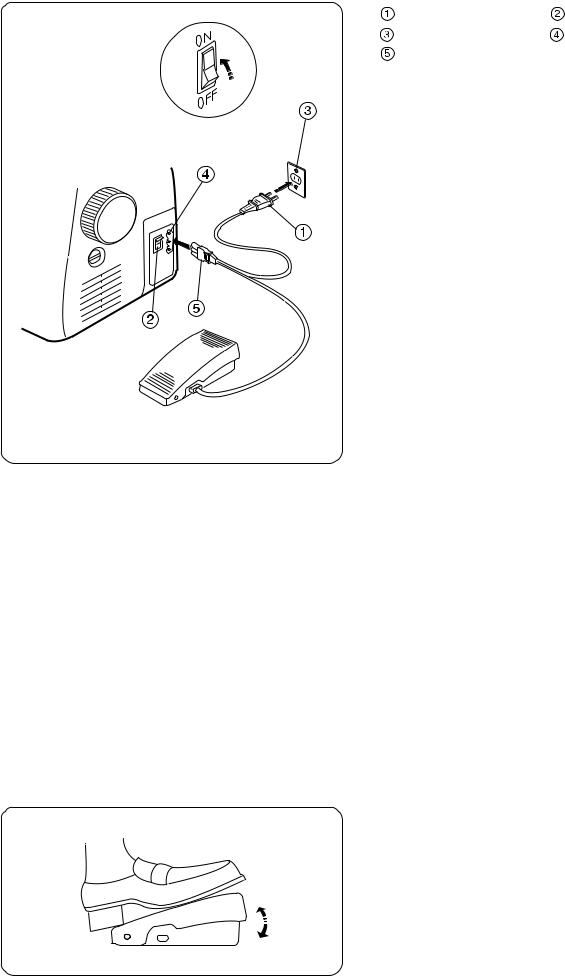
Connecting Machine to Power Supply
Power supply plug |
Power switch |
Outlet |
Machine socket |
Machine plug |
|
Before connecting the power cord, make sure the voltage and frequency shown on the machine conform to your electrical power.
1.Turn off the power switch  .
.
2.Insert the machine plug  into the machine socket
into the machine socket  .
.
3.Insert the power supply plug  into the outlet
into the outlet  .
.
4.Turn the power switch  to turn on the power and sewing light.
to turn on the power and sewing light.
For Your Safety
1.While in operation, always keep your eye on the sewing area, and do not touch any moving parts such as the thread take-up lever, handwheel or needle.
2.Always turn off the power switch and unplug from the power supply:
*When leaving the machine unattended.
*When attaching or removing parts.
*When cleaning the machine.
3.Do not place anything on the foot control, except in use.
Operating Instructions:
The symbol “0” on a switch indicates the “off” position.
“For appliances with a polarized plug (one blade wider than the other).
To reduce the risk of electric shock, this plug is intended to fit in a polarized outlet only one way. If the plug does not fit fully in the outlet, reverse the plug. If it still does not fit, contact a qualified electrician to install the proper outlet. Do not modify the plug in any way.”
“Foot Controller Model 21245 for use with Sewing Machine Model 5124”
(For U.S.A market only).
•Foot Control
Sewing speed can be varied by the foot control.
The harder you press on the control, the faster the machine runs.
5

Sewing Light
(120V)
(A)
(240V)
Nornally, the sewing light comes on when you turn on the main switch.
However, if you prefer to have the sewing light off while sewing, you can open the face plate and access the bulb on/off knob.
Face plate
Switch knob
• To replace the light bulb
NOTE: |
Unplug the power supply before |
|
changing the light bulb. |
CAUSION: |
As the light bulb be HOT, protect your |
|
fingers when you handle it. |
(A)To remove........ Turn to the left. To replace........ Turn to the right.
(B)(B) To remove........ Push and twist to the left. To replace........ Push and twist to the right.
Pressure Dial
The pressure dial should be set at “3” for regular sewing. Reduce the pressure to “2” for appliqué, cutwork, drawn work, basting and embroidery.
Set the pressure to “1” when sewing chiffon, lace, organdy and other fine fabrics. Velours and knits with a lot of stretch may also require a “1” setting.
Pressure dial
Setting mark
To Raise or Drop the Feed Dog
•For button sewing, etc., drop the feed dog.
•After finished sewing, raise the feed dog.
The feed dog must always be up for normal sewing.
Lowered position
Raised position
6
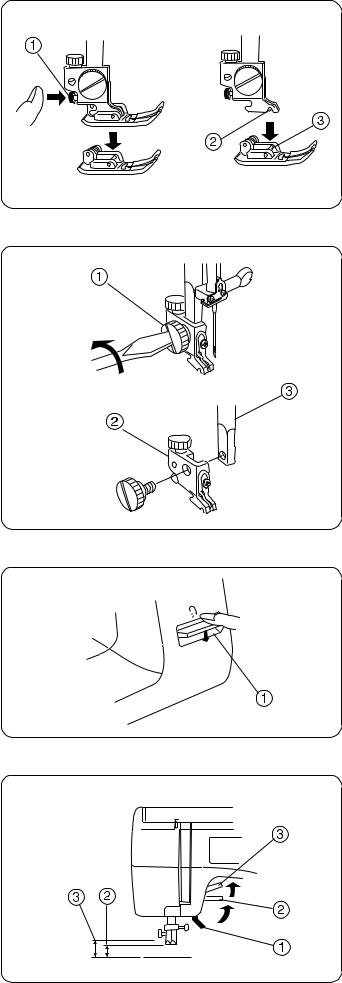
To Remove and Attach Presser Foot
Press the red button on the back of the foot holder.
The presser foot will drop off.
Place the selected presser foot so the pin on the foot lies just under the groove of the foot holder. Lower the presser bar to lock the foot in place.
 Red button
Red button
 Groove
Groove
 Pin
Pin
To Remove and Attach the Foot Holder
To Remove:
Remove the thumb screw by turning the screw counter-clockwise with the screwdriver.
 Thumb screw
Thumb screw
To Attach:
Match the hole in foot holder with the threaded hole in the presser bar.
Fit the thumb screw into the hole. Tighten the screw by turning it clockwise.
 Foot holder
Foot holder  Presser bar
Presser bar
Reverse Button
For as long as you keep the reverse stitch button depressed, the machine sews backwards.
 Reverse button
Reverse button
Presser Foot Lifter
The presser foot lifter raises and lowers your presser foot.
You can raise it about 0.6 cm (1/4”) higher than the normal up position for easy removal of the presser foot or to help you place heavy fabric under it.
 Presser foot lifter
Presser foot lifter
 Normal up position
Normal up position
 High position
High position
7
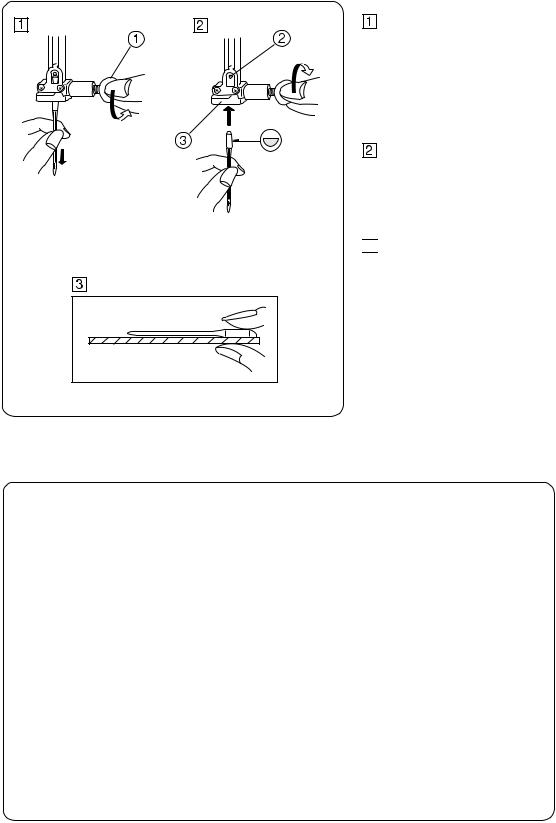
Changing Needle
Raise the needle by pressing the up/down needle position button and lower the presser foot.
Turn off the power switch.
Loosen the needle clamp screw by turning it counterclockwise.
Remove the needle from the clamp.
Insert the new needle into the needle clamp with the flat side to the rear.
When inserting the needle into the clamp, push it up as far as it will go and tighten the clamp screw firmly.


 To find a good needle, put the flat side of the needle onto something flat (a needle plate, glass, etc.).
To find a good needle, put the flat side of the needle onto something flat (a needle plate, glass, etc.).
The gap between the needle and the flat surface should be consistent. Never use a bent or blunt needle.
 Needle clamp screw
Needle clamp screw
 Pin
Pin
 Needle clamp
Needle clamp
Choose Your Needle and Thread
|
FABRICS |
THREADS |
NEEDLE SIZE |
|
|
|
|
|
|
|
Crepe de Chine, |
Fine Silke |
|
|
LIGHT |
Voile, Lawn, |
Fine Cotton |
9 or 11 |
|
Organdy, |
Fine Synthetic |
|||
WEIGHT |
||||
Georgette, Tricot |
Fine Cotton Covered |
|
||
|
|
|||
|
|
Polyester |
|
|
|
|
|
|
|
|
Linens, Cotton, |
50 Silk |
|
|
MEDIUM |
Pique, Serge, |
50 to 80 Cotton |
11 or 14 |
|
Double Knits, |
50 to 60 Synthetic |
|||
WEIGHT |
||||
Percale |
Cotton-covered |
|
||
|
|
|||
|
|
Polyester |
|
|
|
|
|
|
|
|
Denim, Tweed, |
50 Silk |
|
|
HEAVY |
Gabardine, Coating, |
40 to 50 Cotton |
14 or 16 |
|
Drapery, and |
40 to 50 Synthetic |
|||
WEIGHT |
||||
Upholstery Fablic |
Cotton Covered |
|
||
|
|
|||
|
|
Polyester |
|
|
|
|
|
|
NOTE:
*In general, fine threads and needles are used for sewing thin fablics, and thicker threads and needles are used for sewing heavy fablics.
Always test thread and needle size on a small piece of fabric which will be used for actual sewing.
*Use the same thread for needle and bobbin.
*When sewing stretch, very fine fabrics and synthetics, use a blue tipped needle. The blue tipped needle effectively prevents skipped stitches.
8

Winding the Bobbin
• Set the Spool
Lift up the spool pin and place the spool of thread on it with the thread coming off the spool as shown. Press the large spool holder firmly against the spool of thread.
*The small spool holder is used with small or narrow spools of thread.
 Spool pin
Spool pin
 Ordinary spool
Ordinary spool
 Large spool holder
Large spool holder
 Small spool holder
Small spool holder
 Small spool
Small spool
•Removing the Bobbin
Gently slide the hook cover plate release button to the right and remove the cover plate.
Lift out the bobbin.
 Hook cover plate release button
Hook cover plate release button
 Hook cover plate
Hook cover plate
9
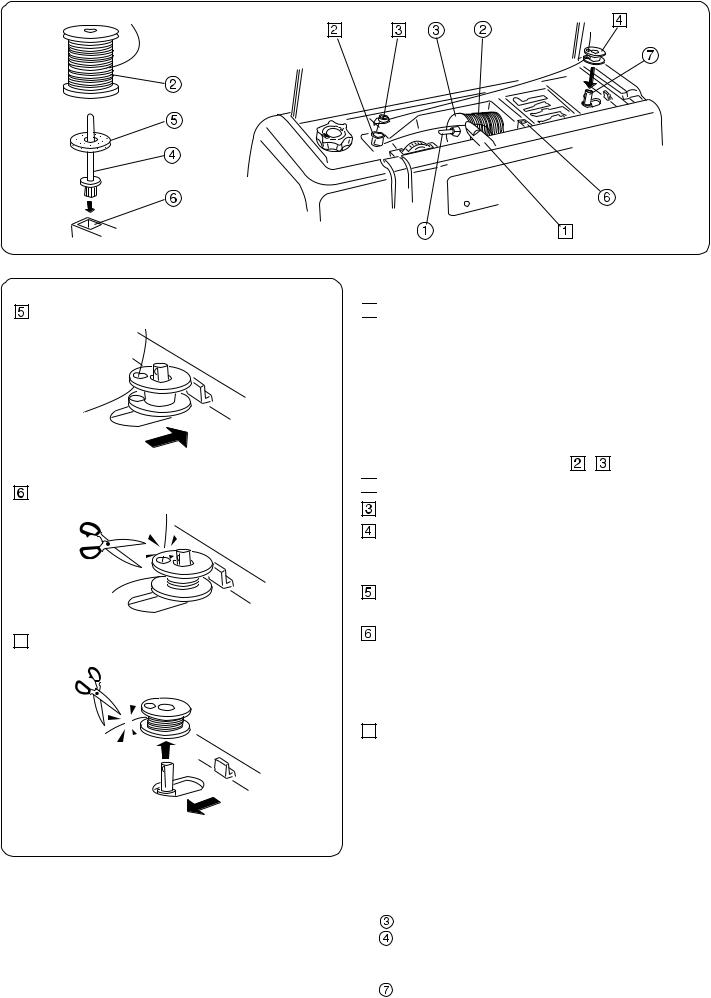
• Winding the Bobbin


 Lift up the spool pin. Place the spool of thread on the spool pin with the thread coming off the spool as shown.
Lift up the spool pin. Place the spool of thread on the spool pin with the thread coming off the spool as shown.
Attach the large spool holder, and press it firmly against the spool of thread.
* |
The small spool holder is used with narrow |
||
|
or small spools of thread. |
|
|
* |
To use the additional spool pin, guide the |
||
|
upper thread as shown in |
, |
. |


 Guide the thread around the thread guide.
Guide the thread around the thread guide.
|
Pass the thread through the thread guide. |
|
|
Thread through the hole in the bobbin from |
|
|
the inside to outside. Put the bobbin on the |
|
|
bobbin winder spindle. |
|
|
Push the bobbin to the right. |
|
|
A red light on the front panel will come on. |
|
7 |
With the free end of the thread held in your |
|
hand, depress the foot control. Stop the |
||
|
||
|
machine when it has made a few turns, and |
|
|
cut the thread close to the hole in the |
|
|
bobbin. |
|
|
7 Depress the foot control again. When the |
|
|
bobbin is fully wound, it will stop automatically. |
|
|
Return the bobbin winder to its original |
|
|
position by moving the spindle to the left, and |
|
|
cut the thread as shown. |
|
|
* The machine will not sew until the spindle is |
|
|
in the left position. |
 Spool pin
Spool pin
 Spool
Spool
Spool holder
Additional spool pin
 Felt
Felt
 Additional spool pin hole
Additional spool pin hole
Bobbin winder spindle
10

1/8 3/8 5/8
10
• Inserting the Bobbin
Place the bobbin in the holder with the thread running off counterclockwise.
End of thread
Guide the thread into the notch |
on the |
front side of the bobbin holder. |
|
Draw the thread to the left, sliding it between the tension spring blades.
Notch 
Continue to draw the thread lightly until the thread slips into notch  .
.
Pull out about 15 cm (6”) of thread.
Notch 
Attach the hook cover plate.
Check the threading by referring to the chart shown on the hook cover plate.
Threading chart
11
